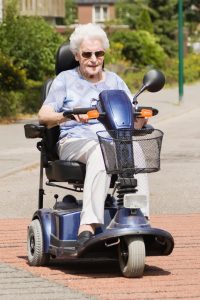 What will happen if I store my scooter in a communal area and do nothing?
What will happen if I store my scooter in a communal area and do nothing?
We will initially ask customers to remove any items from a communal area to keep the space safe. We have to do this by law, so we cannot exercise discretion when we know there is a risk.
If you don’t respond to us and work with us to find a solution, we will serve a legal notice, called a tort notice, giving you formal notice to move the items. If you don’t we will remove them and charge you the costs. If we store any items, you will have to pay the costs and we will dispose of any items in storage after a fixed period of time.
What are the risks of storing scooters in communal areas?
Mobility scooters involved in a fire can release large volumes of smoke and generate significant heat outputs. If mobility scooters are stored on escape routes and are involved in a fire, there is a potential that escape routes will become impassable and residents could be placed at significant risk in the event of a fire. Therefore, appropriate measures must be considered within the building fire risk assessment to address the risks posed by the storage and charging of mobility scooters.
Mobility scooters are generally constructed around a steel frame, with plastic fairings, rubber tyres, foam seats, wiring and batteries. They are often retro fitted with vehicle registration number plates, waterproof covers and storage bags.
The type of batteries used in mobility scooters are generally lead acid (wet cell) or sealed lead acid scooter batteries. Other battery types include Gel and Absorbed Glass Mat (AGM) batteries.
The recent use of lithium iron phosphate (LiFeP04) batteries instead of lead acid batteries to power mobility scooters has increased risks due to their unpredictable and adverse reaction when subjected to fire. All batteries can give off hydrogen when charging.
 Is your home suitable?
Is your home suitable? I already have a scooter, but have nowhere to store it – what can I do?
I already have a scooter, but have nowhere to store it – what can I do? What will happen if I store my scooter in a communal area and do nothing?
What will happen if I store my scooter in a communal area and do nothing?